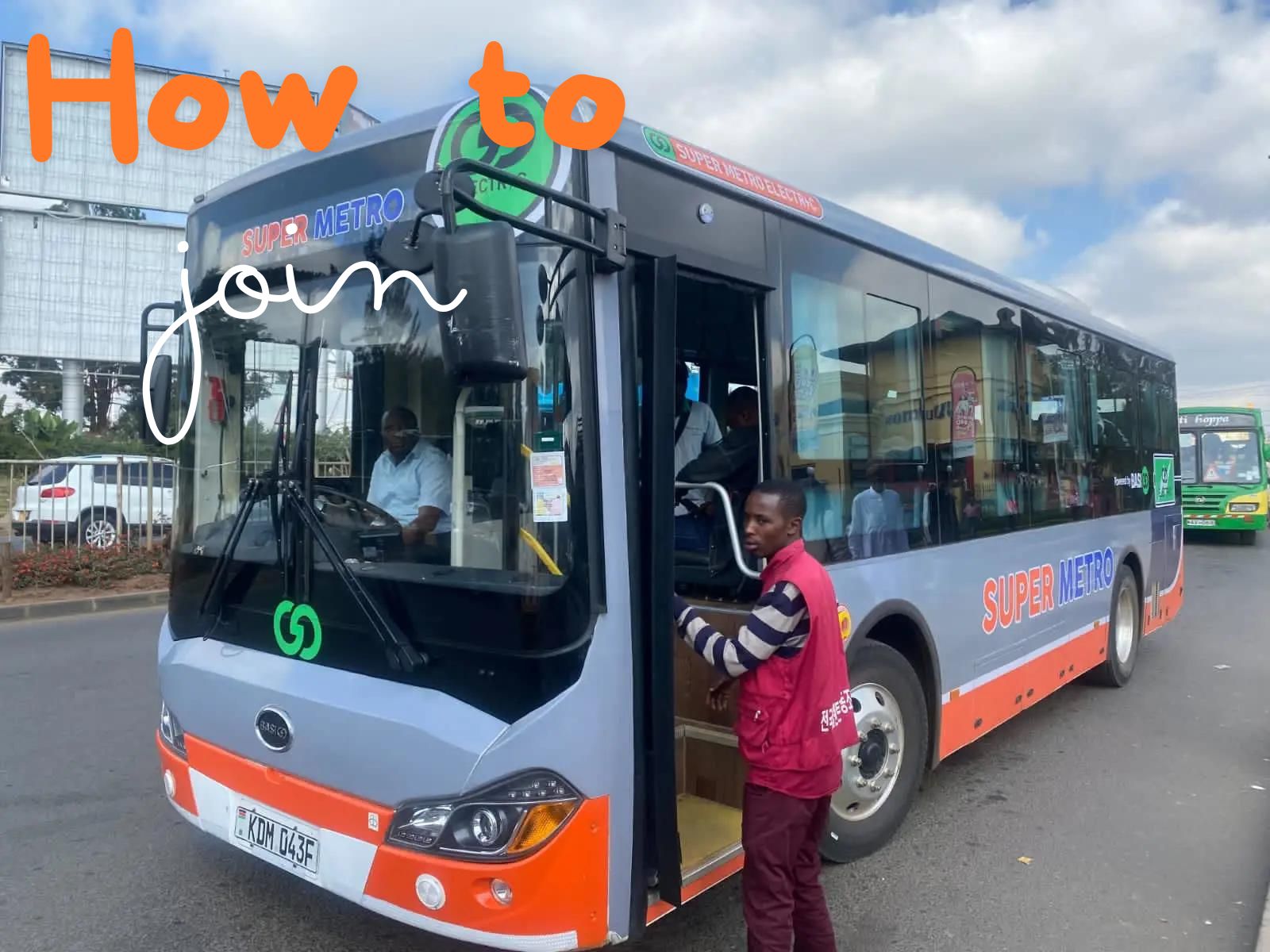
Are you Looking for Info on how to join Super metro Sacco? Here’s are intricacies of membership, particularly the investment requirements.
Super Metro Sacco has become synonymous with reliable and comfortable public transportation in Nairobi. But for some, the opportunity extends beyond ridership. ‘
Becoming an investor with the Sacco offers a potentially lucrative path to financial gain. If you’re considering joining Super Metro Sacco, understanding the intricacies of membership, particularly the investment requirements, is crucial.
Here’s How to Join Super Metro Sacco:
This comprehensive guide delves into the details of becoming a Super Metro Sacco investor, equipping you with the knowledge to make informed decisions.
We’ll explore financing options, fee structures, and the costs associated with acquiring a matatu (minibus) through the Sacco.
Financing Your Investment to Owning the Road
Super Metro Sacco recognizes that aspiring investors come with varying financial capabilities. To cater to this diversity, the Sacco offers two financing options:
- Self-Funding: For those with the financial muscle, self-funding allows for outright ownership of the matatu. This eliminates the need for loan repayments but necessitates a larger upfront investment.
- Sacco Financing: This option empowers individuals with a smaller capital base to participate in Super Metro’s success story. The Sacco helps finance the matatu purchase, with the investor making regular repayments over a predetermined period.
All Requirements to Join Supermetro Sacco:
Regardless of the financing route you choose, several fees are involved in becoming a Super Metro Sacco investor. Here’s a breakdown of the key costs:
1. Registration Fee:
This fee covers the administrative costs associated with joining the Sacco and onboarding you as a member. (Estimated Cost: Ksh. 5,000)
2. Share Capital:
As a member, you’ll contribute to the Sacco’s shared capital, fostering a sense of collective ownership and shared prosperity. (Estimated Cost: Ksh. 10,000)
3. Entrance Fee:
A one-time fee levied upon becoming an investor. The fee can vary depending on whether you self-finance the matatu or utilize the Sacco’s facilitation service. (Estimated Cost: Ksh. 50,000 for self-financing, Ksh. 100,000 for Sacco facilitation)
4. Matatu Deposit:
This functions as a down payment on the matatu, and may be financed by the Sacco depending on your chosen investment path. (Estimated Cost: 30% of the matatu cost, which is currently around Ksh. 1,956,000 based on a Ksh. 6,520,000 estimated matatu price)
5. Monthly Loan Installments (if applicable):
If you opt for Sacco financing for your matatu, you’ll have monthly installments to repay the loan over the agreed-upon term. (Estimated Cost: Ksh. 121,000 per month for a 48-month loan)
Additional Costs to Consider
In addition to the core fees outlined above on how to Join Super Metro Sacco, several other expenses come into play when investing in a matatu through Super Metro Sacco:
- Processing Fees: The Sacco incurs administrative costs in processing your loan application. These fees are passed on to you as processing fees. (Estimated Cost: 1% of the matatu cost, which is approximately Ksh. 65,200)
- Debenture Fees: This may be required as a security deposit, acting as a guarantee against potential defaults on loan repayments. (Estimated Cost: Ksh. 20,000)
- Tracking Device Fees: For security purposes and real-time vehicle monitoring, Super Metro Sacco equips its matatus with tracking devices. Investors are responsible for covering the associated fees. (Estimated Cost: Ksh. 25,000)
- TLB Fees: The Traffic Law and Licensing Board (TLB) levies fees for permits and certifications necessary for operating a matatu legally. These fees are borne by the investor. (Estimated Cost: Ksh. 4,500)
- Comprehensive Insurance: Protecting your investment is crucial. Comprehensive insurance safeguards your matatu against unforeseen circumstances like accidents, theft, or fire. (Estimated Cost: Ksh. 55,000)
- Seasonal County Fees: Depending on the counties where your matatu operates, you may incur seasonal fees for permits and operational licenses. (Estimated Cost: Ksh. 13,880 for Nairobi, Kiambu, Kajiado, and Machakos counties)
Cost Breakdown of a Matatu Through Super Metro Sacco
While definitive figures may vary, the information gleaned from various sources offers a ballpark estimate of the investment required:
- Total Cost of Isuzu NQR Matatu: Approximately Ksh. 6.5 million.
- Required Deposit (30%): Ksh. 1.96 million.
- Sacco Financing (Remaining Balance): Ksh. 4.54 million.
- Loan Repayment Period: 48 months.
- Monthly Loan Installments: Ksh. 121,000.
- Total Loan Repayment: Ksh. 5.8 million.
Important Considerations Before Investing
Investing in a matatu through Super Metro Sacco presents an attractive opportunity to generate income. However, it’s prudent to carefully consider all aspects before making a decision. Here are some key factors to weigh:
- Upfront Investment: The initial investment, including the deposit, potential financing fees, and the matatu itself, can be substantial.
- Operational Costs: Maintaining and operating a matatu involves ongoing expenses like fuel, spare parts, driver salaries, and maintenance.
- Market Fluctuations: Passenger volumes and fares can fluctuate, impacting your potential income. Understanding local transportation trends and ridership patterns is crucial.
- Management Responsibilities: As an investor, you’ll be responsible for overseeing the day-to-day operations of your matatu. This may involve finding qualified drivers and conductors, ensuring proper maintenance, and managing finances.
Additional Considerations:
- Competition: The matatu industry in Nairobi is competitive. Researching routes, understanding passenger needs, and offering a reliable and comfortable service are essential for success.
- Legal and Regulatory Compliance: Operating a matatu requires adherence to various laws and regulations set forth by the Kenyan government. Familiarize yourself with these regulations to avoid penalties or disruptions.
- Taxes: As an investor, you’ll be responsible for paying taxes on your matatu earnings. It’s advisable to consult with a tax professional to ensure you’re compliant with all tax regulations.
The Next Steps of Joining Super Metro Sacco
If you’ve carefully considered the investment requirements, ongoing costs, and responsibilities involved, and you’re still interested in becoming a Super Metro Sacco investor, here are the next steps:
- Contact Super Metro Sacco Directly: The most up-to-date information on investment requirements, fees, and the application process can be obtained directly from Super Metro Sacco. Their contact details can likely be found on their website or by searching online directories.
- Prepare Your Finances: Gather the necessary documents and secure the required capital to cover the initial investment and potential ongoing costs.
- Develop a Business Plan: Create a comprehensive business plan outlining your investment strategy, operational approach, and projected income and expenses.
- Seek Professional Advice: Consult with an accountant or financial advisor to ensure the financial viability of your investment and understand the tax implications.
Becoming an investor with Super Metro Sacco can be a rewarding experience by following this guide on How to Join Super Metro Sacco.
Thus, offering the potential for financial gain and contributing to Nairobi’s vibrant public transportation network. By carefully considering all aspects of the investment, conducting thorough research, and preparing a solid business plan, you can increase your chances of success in this dynamic industry.






What is the average monthly return? If i am able to raise 50% of the what is the EMR?